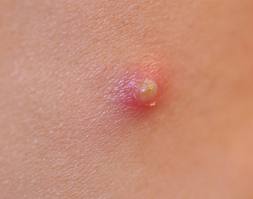
What is Boil? How to manage it? What are the precautions to be taken? What are the signs and symptoms? What is the cause of this disease? How to treat it? How can homeopathy help you? All of this answered, in this post and of course our doctors always there to help you. Just fill in your details in the form down below and we will answer all your questions for FREE!

What is boil?
A boil also known as furuncle is an infection of the hair follicle by staphylococci bacteria which is present on the skin, the boil is a deep folliculitis. It is also defined as the swollen and red painful lump under the skin.
The infection in the hair follicle is caused by the bacterium Staphylococcus aureus results in the painful swollen area on the skin with an accumulation of pus and dead tissue.
When individual boils are clustered together, they form carbuncle and are interconnected with each other under the skin.
What does a boil look like?
Boils, also called furuncles or abscesses, boils are infected hair follicles. It’s caused by bacteria staphylococcus aureus painful swellings. A boil looks like as a firm, red, painful limp under the skin’s surface.
What are the factors that triggers boil?
There are various causes of boils and are as following:-
• Excessive perspiration
• Occlusion of the hair follicular gland.
• Follicular trauma.
• Friction to the root of the hair.
• Any prior skin injury.
• Patients with reduced immune status are more prone to develop boils.
• The most common bacteria involved in the formation of the boil and causing infection is Staphylococcus aureus.
Risk factors involved in the formation of boils are as follows: –
• Diabetic persons are more prone to develop these skin infections from bacteria as in this disease it becomes more difficult for the body to fight against infections.
• Individuals are more prone to develop infection for boil if they are in close contact with the person who has a staph infection.
• Other skin conditions such as acne and eczema damage the skin’s protective barrier and lead to the formation of boils and make skin more prone to get infections.
• Individuals whose immunity is low are more prone to develop boils and carbuncles.
What are the symptoms of boil?
Boils mainly appear on face, neck, armpits, buttocks or thighs. Signs and symptoms shown by the boils are as follows
• Boil appears as a red painful bump about the size of a pea.
• There is swelling and redness around the bump.
• When this infection is not treated at an early stage there occurs an increase in the size of the bump and then this bump is filled with the pus and sometimes it can reach to the size of a golf ball.
• There is the development of yellow and white tip on the bump and this tip has an opening that ruptures and allows the pus to drain out.
• Sometimes when infection is severe there occur fever along with the pain and swelling in the boil.
• The patient feels chills.
• There is weakness and lethargy felt to the patient.
• Generally, patient feels unwell.
As soon as the boil is ruptured the pain vanishes or decreased depending on the severity of the boil.
What does a boil look like?
Boils is also known as furuncles or abscesses occur due to bacteria staphylococcus aureus which causes painful swellings, but other bacteria and fungus can cause boils too. It starts as a firm, red, painful limp under the skin’s surface.
What are the complications?
• Boils can lead to scarring.
• Infection increases and reaches deeper parts of the skin.
• Abscess of the skin, brain, spinal cord, and other organs.
• The infection spread to bloodstream causing bacteremia.
• Sepsis
• Carbuncle.
• Osteomyelitis.
• Endocarditis.
• Toxic shock syndrome.
What are the homeopathic indications for a boil?
Belladonna
Calcarea sulphurica
Hepar sulphuris calcareum
Mercurius solubilis
Silicea
Lachesis mutus
For more information, you can visit WebMD and MedicineNet.
We have a strong web presence all across the globe with patients in major countries like United States, Australia, United Arab Emirates, Canada, United Kingdom, most European countries, & even smaller counties like Uganda, Nepal, Bangladesh and many more.
We have a very efficient team of doctors which includes the right combination of highly experienced doctors and the doctors of the new age.
Our main aim is to make the patient comfortable so that the case can be taken with ease and the patient be treated properly.
** The text on this website is sourced from websites like emedicine and/or other verified material by government agencies around the globe along with valuable inputs and additions by our team. The content of this page is proofread and updated by the team of doctors, every once in a while, to provide the most accurate information.
Symptoms of PSP include tingling lips and tongue, numbness, difficulty breathing and eventual paralysis. Death from PSP can happen as soon as 30 minutes after extreme exposure. Luckily, PSP is
http://magdalenabus.tk/page/what-does-it-mean-when-your-lips-burn/